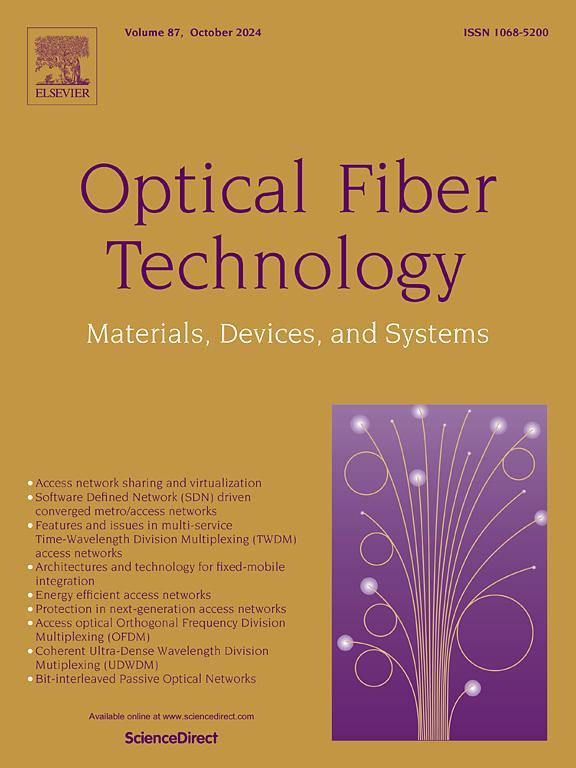Laser-oriented design and performance analysis of series-parallel lyot filters with cross-output
IF 2.7
3区 计算机科学
Q2 ENGINEERING, ELECTRICAL & ELECTRONIC
引用次数: 0
Abstract
In this study, a fiber comb filter with switchable channel intervals is designed. The structure is composed of two Lyot filters connected in parallel via two polarization beam splitters (PBS), with two circulators (CIR) added to connect the two branches in series, enabling cross output. The transfer function of the filter is derived and analyzed using transfer matrix theory. Simulation results indicate that the filter can generate two small channel intervals and one large channel interval. Experimental testing confirms three channel intervals consistent with theoretical predictions, namely 0.2 nm, 4.36 nm, and 0.3 nm. Additionally, a fourth small channel interval of 0.46 nm is achieved by adjusting the angular difference between the principal axis of the PBS and the principal axis of the polarization-maintaining fiber (PMF). It is also observed that the extinction ratio (ER) and peak wavelength of the filter can be tuned by varying the rotation angle of the polarization controller (PC). A randomly distributed feedback fiber laser (RDFBFL) based on the designed filter is demonstrated to achieve switchable channel intervals across five laser channels. At room temperature, the maximum wavelength drift of the central wavelength over 30 min is measured to be 0.082 nm, while the maximum peak power fluctuation is 1.09 dB. Furthermore, the tunability and stability of a multi-wavelength fiber laser (MWFL) based on the filter are evaluated. With four laser channels, the channel intervals remain switchable, and the output power fluctuation of the new channel intervals is less than 1.07 dB within 30 min, while the frequency drift is less than 0.258 nm.
交叉输出串并联lyot滤波器面向激光的设计与性能分析
本文设计了一种信道间隔可切换的光纤梳状滤波器。该结构由两个Lyot滤波器组成,通过两个偏振分束器(PBS)并联连接,加上两个环行器(CIR)串联连接两个分支,实现交叉输出。利用传递矩阵理论推导并分析了滤波器的传递函数。仿真结果表明,该滤波器可以产生两个小信道间隔和一个大信道间隔。实验测试证实了三个通道间隔与理论预测一致,分别为0.2 nm、4.36 nm和0.3 nm。此外,通过调整偏振维持光纤(PMF)主轴与PBS主轴之间的角差,实现了第四个小通道间隔0.46 nm。通过改变偏振控制器(PC)的旋转角度,可以调节滤波器的消光比(ER)和峰值波长。基于所设计滤波器的随机分布反馈光纤激光器(RDFBFL)在五个激光通道之间实现了可切换的通道间隔。在室温下,中心波长在30 min内的最大波长漂移为0.082 nm,最大峰值功率波动为1.09 dB。此外,还对基于该滤波器的多波长光纤激光器的可调性和稳定性进行了评价。采用4个激光通道时,通道间隔保持可切换性,30 min内新通道间隔输出功率波动小于1.07 dB,频率漂移小于0.258 nm。
本文章由计算机程序翻译,如有差异,请以英文原文为准。
求助全文
约1分钟内获得全文
求助全文
来源期刊

Optical Fiber Technology
工程技术-电信学
CiteScore
4.80
自引率
11.10%
发文量
327
审稿时长
63 days
期刊介绍:
Innovations in optical fiber technology are revolutionizing world communications. Newly developed fiber amplifiers allow for direct transmission of high-speed signals over transcontinental distances without the need for electronic regeneration. Optical fibers find new applications in data processing. The impact of fiber materials, devices, and systems on communications in the coming decades will create an abundance of primary literature and the need for up-to-date reviews.
Optical Fiber Technology: Materials, Devices, and Systems is a new cutting-edge journal designed to fill a need in this rapidly evolving field for speedy publication of regular length papers. Both theoretical and experimental papers on fiber materials, devices, and system performance evaluation and measurements are eligible, with emphasis on practical applications.
 求助内容:
求助内容: 应助结果提醒方式:
应助结果提醒方式:


